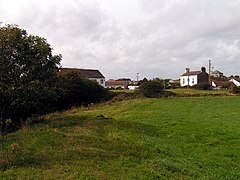Braystones is a village in Cumbria, England, historically within Cumberland. It is located on the Irish Sea coast, on edge of the Lake District National Park, around 38.6 miles (62.1 km) north of Barrow-in-Furness, 9.9 miles (15.9 km) south of Whitehaven and 50.8 miles (81.8 km) south west of Carlisle.
| Braystones | |
|---|---|
 Braystones | |
Location within Cumbria | |
| OS grid reference | NY0005 |
| Civil parish | |
| District | |
| Shire county | |
| Region | |
| Country | England |
| Sovereign state | United Kingdom |
| Post town | BECKERMET |
| Postcode district | CA21 |
| Dialling code | 01946 |
| Police | Cumbria |
| Fire | Cumbria |
| Ambulance | North West |
| UK Parliament | |
Traditionally a scattered community based on agriculture, it has grown considerably during the 20th century by firstly, the construction of holiday cabins on the beach, and latterly by the creation of large caravan parks. It has long been a popular holiday area.
Governance
editBraystones is in the parliamentary constituency of Copeland, Trudy Harrison is the Member of parliament.
For Local Government purposes it is in the Beckermet Ward of Borough of Copeland and the Gosforth Ward of Cumbria County Council.
The village has its own Parish Council; Lowside Quarter Parish Council.[1]
Nuclear
editIn 2009, Braystones was approved by the British government as a site for a new nuclear power station.[2] However, the site was ruled out by Secretary of State for Energy and Climate Change Chris Huhne in October 2010 for environmental reasons with the former government's list of eleven potential sites reduced to eight.[3]
Transport
editBraystones railway station is on the Cumbrian Coast Line and has been served by the railway since 1850.[citation needed]
Gallery
edit-
Braystones from the north
-
Braystones beach
-
Cumbrian Coast rail line at Braystones
-
Braystones beach
References
edit- ^ "Lowside Quarter Parish Council".
- ^ Go-ahead for 10 nuclear stations, BBC News, 9 November 2009
- ^ "Nuclear power: Eight sites identified for future plants". BBC News. 18 October 2010. Retrieved 18 October 2010.
External links
edit- Cumbria County History Trust: Lowside Quarter (nb: provisional research only – see Talk page)

